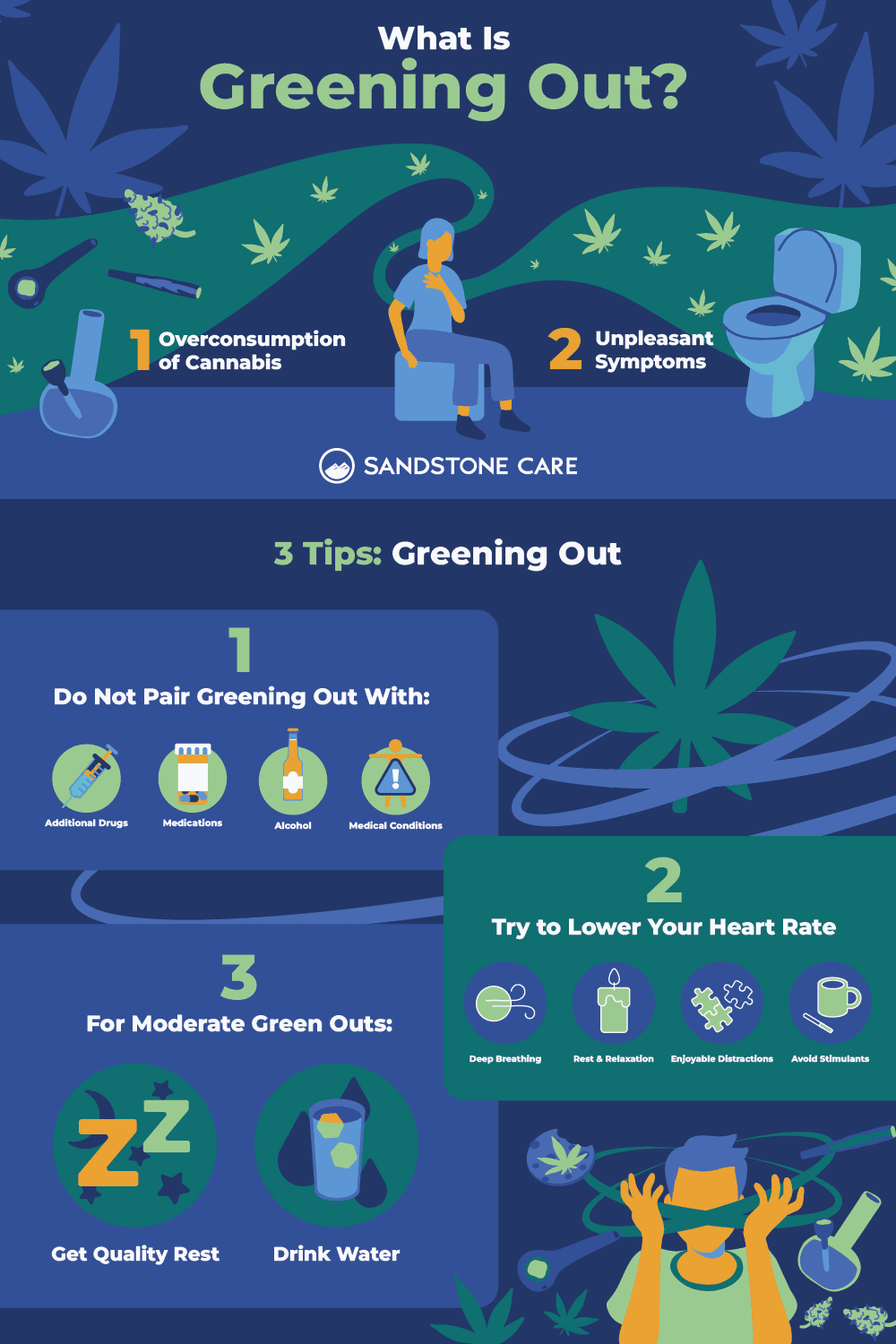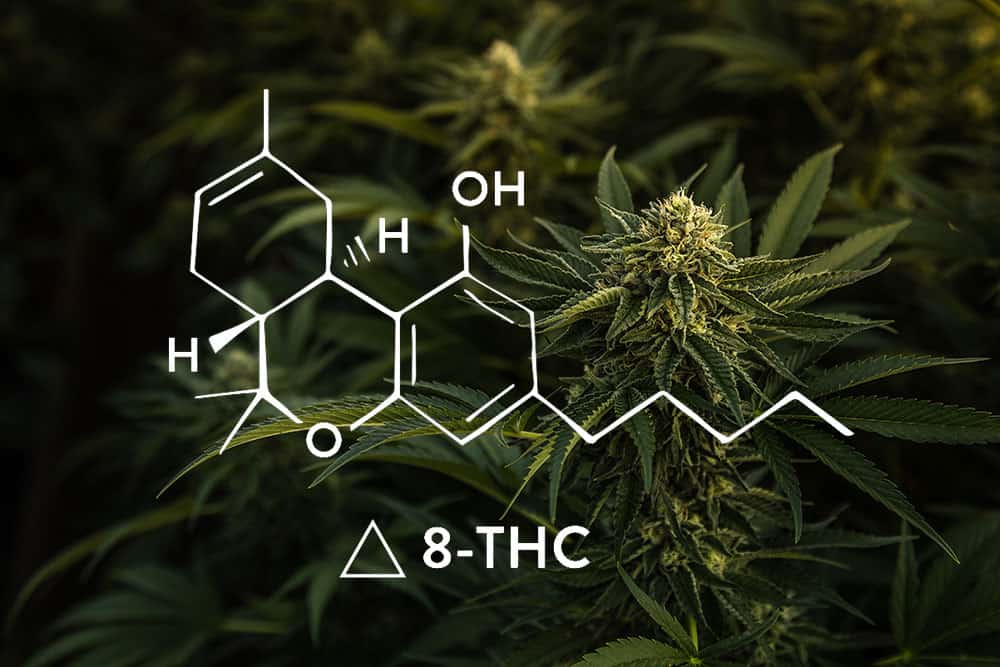Greening Out Overview
What is Greening Out?
Greening out happens when a person consumes or smokes too much cannabis or marijuana, essentially a “cannabis overdose.” This can cause symptoms like dizziness, nausea, hallucinations, and panic attacks.
They may also show other physical and psychological symptoms such as paleness, loss of mobility, anxiety or paranoia, disorientation, and memory loss.
While greening out is not normally a medical emergency, it can be incredibly distressing for the person who is experiencing it. In some cases, users may have serious symptoms that make it difficult for them to function.
Greening out most commonly happens to people who are smoking weed for the first time, have a low tolerance, or are mixing their cannabis with another substance like alcohol.

It is important to note that certain cannabis products are most commonly used to get high, while others are more commonly used for medical purposes.
The cannabis products used to get high typically contain the chemical delta-9-tetrahydrocannabinol, otherwise known as THC.
The National Institute on Drug Abuse (NIDA) explains this is “The main psychoactive (mind-altering) chemical in marijuana, responsible for most of the intoxicating effects that people seek…”
The other product most commonly derived from the cannabis plant is cannabidiol, also known as CBD.
CBD is typically used for medical purposes, and while it contains low dosages of THC, it does not have the same effects. The products produced from this chemical are often used for symptom management of chronic illness or chronic pain.
In this article, we will most commonly refer to cannabis products containing high levels of THC.

What Is a Cannabis Green Out?
A cannabis green out is when someone feels sick or ill after smoking or consuming cannabis products with high levels of THC.
This is the term people often use to describe using too much weed.
What Is the Term for Greening Out?
Greening out is also called “cannabis overdose,” in which the person gets “too high.” It is sometimes referred to as being “greened up.”
How Long Does Greening Out Usually Last?
Greening out usually lasts for a few minutes, hours, or even all day. Generally speaking, symptoms will likely go away after 24 hours.
If you are still not feeling well after 24 hours, reach out to a medical professional. This is especially important if you consumed other substance like alcohol along with the cannabis, since mixing substances can make symptoms worse or add in new effects altogether.
How long greening out lasts will depend on the person’s hydration levels, tolerance, amount consumed, and how quickly it was consumed.

What Does Greening Out Feel Like?
When a person greens out, they may start to feel ill. They can experience symptoms such as dizziness, light-headedness, anxiety, increased heart rate, nausea, vomiting, or loss of coordination.
A person may experience what some people call “the spins,” which is a mixture of vertigo and nausea that can make a person feel that their head is spinning, even if they are lying down.
What Does Start Greening Mean?
When a person starts greening, they experience the physical and psychological effects of too much cannabis in their system.
What Causes Greening Out?
Greening out can be caused by consuming too much cannabis product or marijuana or by mixing them with other substances, such as alcohol.
What Are the Signs of Greening?
Common signs of greening out can include:
- Pale skin
- Slurred speech
- Dry mouth
- Paranoia
- Nausea and vomiting
- Loss of coordination
- Dizziness
- Light-headedness
- High eyes
- Panic attack
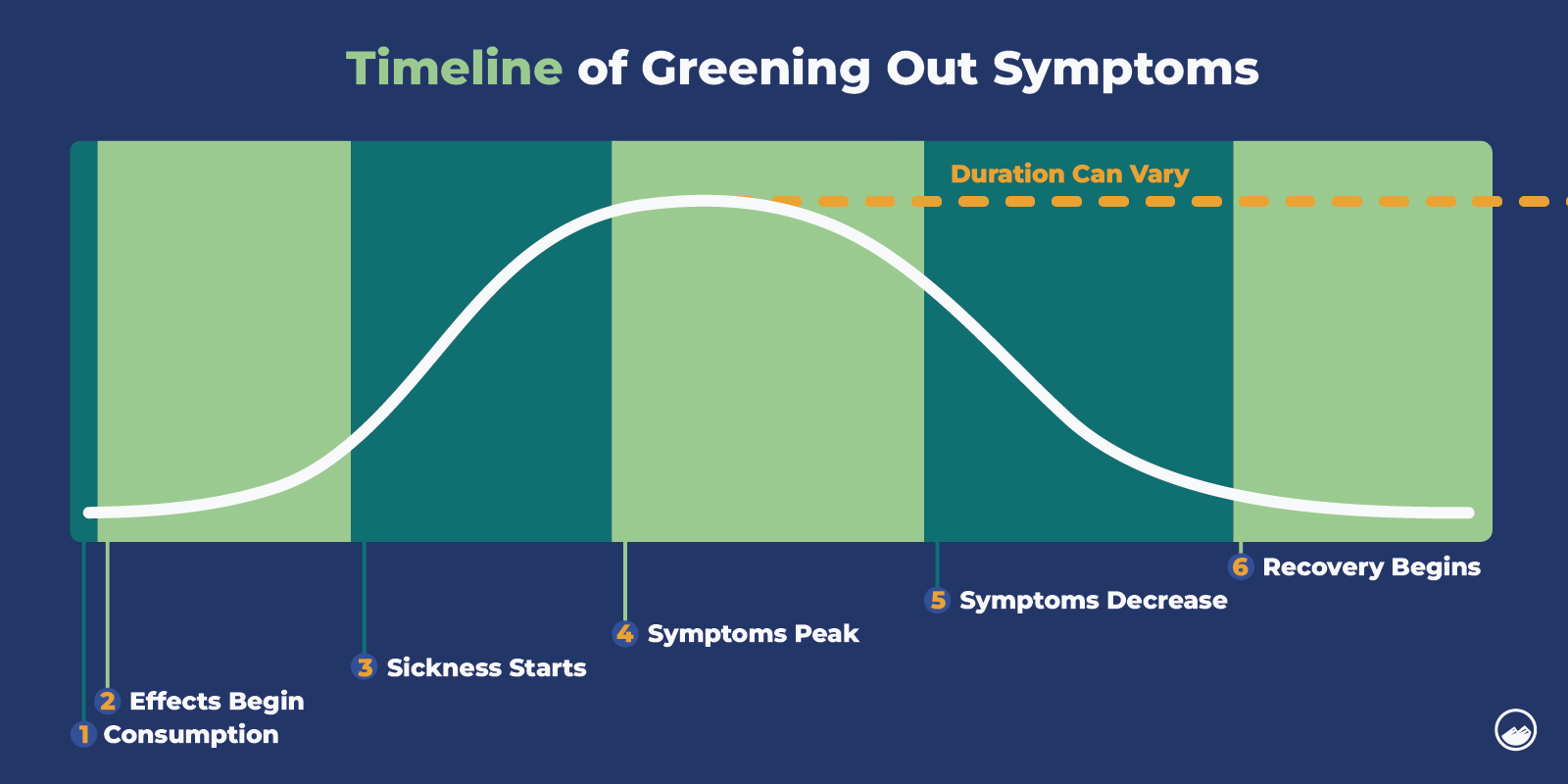
Greening Out Symptoms
What Are the Symptoms of Greening Out?
Common symptoms of greening out include:
- Nausea
- Vomiting
- Dizziness
- Light-headedness
- Disorientation
- Loss of coordination
- Confusion
- Feeling of heaviness in the limbs
- Mild hallucinations
- Anxiety
- Paranoia
- Increased heart rate
- Lowered blood pressure
How Can You Tell If You’re Greened Out?
If you have been smoking weed, consuming edibles, “dabbing,” smoking wax, or vaping marijuana and start to experience any of these symptoms, you may be greened out.
The most common side effects are dizziness, nausea, anxiety, and increased heart rate.

What Are the Benefits of Greening?
Greening can cause very uncomfortable symptoms and can put you in dangerous situations. Greening out on purpose is not recommended, as it can lead to life-threatening situations for some.
How Long Does It Take to Sober Up After Greening Out?
The time it takes to sober up after greening out can be different for everyone. Factors such as:
- Body weight
- Hydration levels
- Tolerance to Weed
- Potency of what they smoked
- Other health conditions
It will impact how long it will take to get the substances out of your system. Typically, symptoms will reside within 24 hours or less.
What Is Cannabis Depersonalization?
Cannabis depersonalization happens when someone feels disconnected from themselves or their surroundings after using anything with THC.
It can feel like you’re watching yourself from outside your body or like things around you aren’t real. People might also feel emotionally numb or that their thoughts don’t feel like their own.
This can be connected to greening out, which is when someone feels sick or anxious after using too much cannabis. Greening out can cause nausea, dizziness, and panic, and during this, some people might also experience depersonalization.
What Is a Pot Panic Attack?
A pot panic attack is a strong anxiety reaction caused by using cannabis. This can often happen when someone is greening out as part of them becoming overwhelmed after taking too much.
Along with physical symptoms like nausea and dizziness, a person might also feel intense panic, with a racing heart (sometimes caused weed palpitations), trouble breathing, or a sense of fear. These reactions usually come from consuming too much THC.
People with anxiety are more likely to use cannabis, hoping it will calm them down. But for some, it can have the opposite effect.
During a pot panic attack, some might use more cannabis to try to relax, but this can actually make anxiety and panic worse, creating a cycle where the more they use, the more anxious they feel.
Can Weed Cause Headaches?
Yes, weed can cause headaches. While cannabis is often used to relieve pain, including headaches, some people experience headaches as a side effect, especially after consuming large amounts of THC.
This can add to the discomfort during a greening out episode, where a person may already feel nauseous, dizzy, or anxious.
Frequent cannabis users may also get rebound headaches when the effects wear off, which can lead to consuming more cannabis to manage the pain, potentially increasing the risk of greening out.
Additionally, smoking cannabis can trigger headaches due to the irritation from smoke, further contributing to the overall physical discomfort during a greening out experience.
Can You Throw Up From Greening Out?
Many people who are greening out can experience nausea and may throw up from the overconsumption of marijuana.
Long-time users can develop a condition called cannabinoid hyperemesis syndrome (CHS). StatPearls explains that CHS “is a condition in which a patient experiences cyclical nausea, vomiting, and abdominal pain after using cannabis.”
Vomiting can quickly cause dehydration, becoming dangerous if not treated properly.
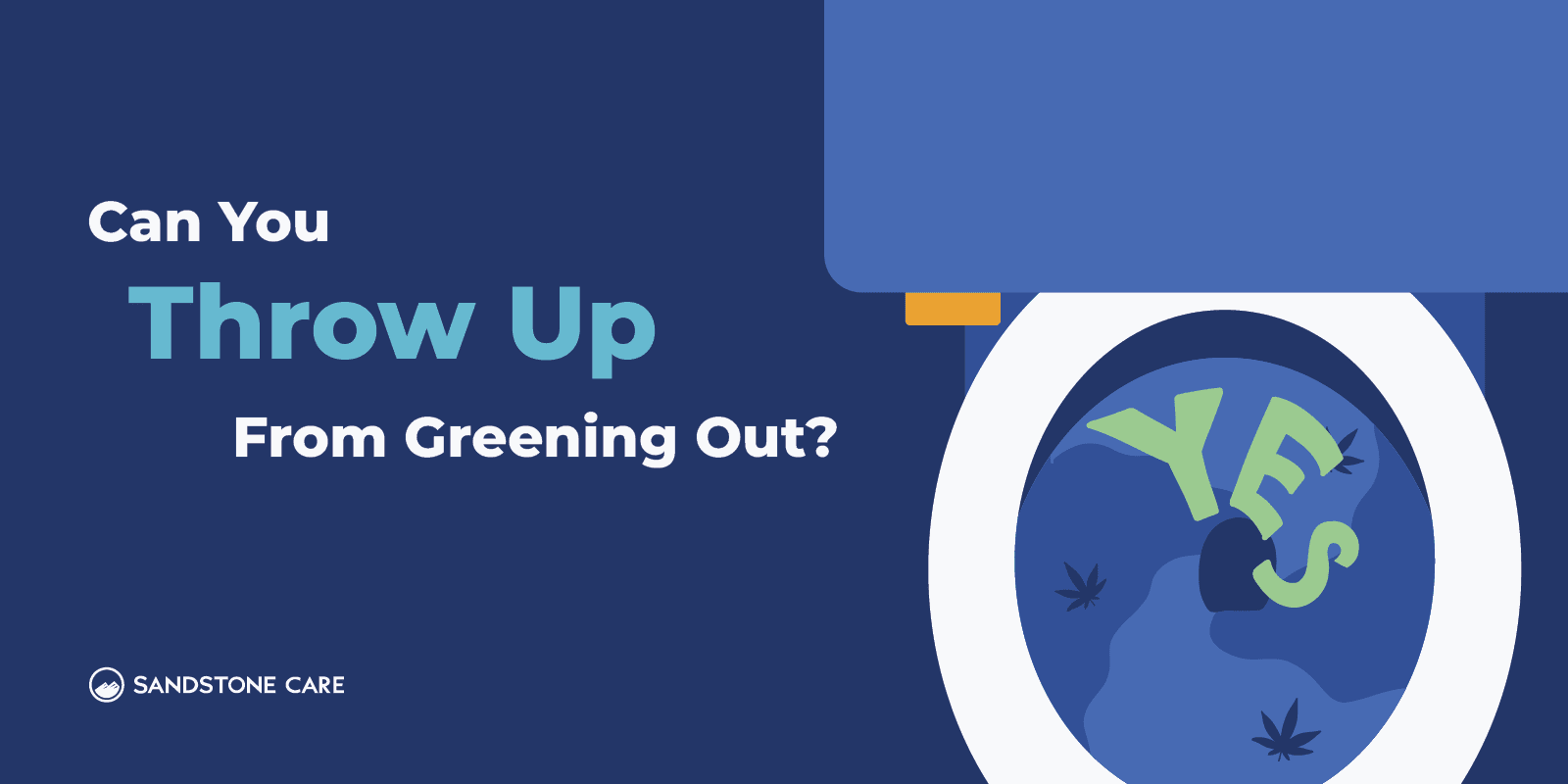
Greening Out After Effects
Can Greening Out Last For Days?
Greening out symptoms typically subside within 24 hours of consumption; however, the duration of the symptoms will depend on how much cannabis product is consumed, how quickly it is consumed, and how it enters the bloodstream.
What Are the Long-Term Effects of Greening Out?
The long-term effects of consuming cannabis products will depend on the potency, amount, rate, and consistency it is consumed. Everyone reacts to substances differently, especially if other health conditions or substances are present.
The common long-term side effects of greening out are still being discovered; however, it is known that having a marijuana addiction (also known as marijuana use disorder) may lead to:
- Memory loss
- Learning impairments
- Difficulty regulating impulse control
- Lower IQ
- Exacerbated negative mental health symptoms or conditions
- Compromised lung health (most common with smoking or vaping)
- Increased likelihood of respiratory infections, such as pneumonia (most common with smoking or vaping)
- Higher risk of cardiovascular complications, like heart attack
- Marijuana dependency
Can You Have Permanent Brain Fog From Weed?
It’s unlikely that weed causes permanent brain fog, but some people might feel like their thinking is fuzzy or slow for a while after using a lot of cannabis.
For people who use cannabis a lot, especially with high-THC strains, brain fog can stick around even after the effects of greening out wear off.
The good news is that these symptoms usually improve over time if a person cuts back or stops using cannabis, and permanent brain fog is rare.
What Are the Potential Side Effects of Greening Out?
- Increased heart rate
- Dizziness or light-headedness
- Nausea
- Vomiting
- Paranoia
- Hallucinations
- Anxiety
- Panic attacks
- Decreased blood sugar
- Inability to focus
- Disorientation
- Chills
- Sweating
- Blurred vision
What is Weed Disassociation?
Weed dissociation refers to a mental state in which a person feels disconnected from reality, themselves, or their surroundings after consuming marijuana.
It can involve feeling detached from one’s thoughts, body, or emotions, almost like being an observer rather than fully present in the moment. This dissociative experience is often described as feeling “spaced out” or “numb.”
Is Greening Out Dangerous?
Greening out can become dangerous, especially if it is combined with other substances or medical conditions.
Can You Die If You Get Too High?
No, you cannot die directly from getting too high on cannabis. Unlike substances like opioids or alcohol, cannabis doesn’t cause fatal overdoses because it doesn’t shut down basic life functions like breathing.
However, consuming too much—especially high-THC products—can lead to very uncomfortable symptoms like anxiety, panic attacks, nausea, vomiting, confusion, and greening out.
NIDA states that there have not been any reported deaths from marijuana use alone. However, death can occur if mixed with other substances, especially if they are used improperly or overdosed.
Combining substances, like nicotine, alcohol, opioids, and stimulant drugs, can cause the chemicals to interact and intensify symptoms.
This can become very dangerous very quickly, especially since there are not many regulations to control the potency or purity of cannabis. As a result, the user may not know that they are consuming additional substances.
If cannabis products are laced with any other substance, such as:
- Fentanyl
- Cocaine
- Methamphetamine (Meth)
- Heroin
- PCP
- Ketamine
Symptoms from these substances can quickly become life-threatening.
While symptoms weed can feel intense, they aren’t life-threatening on their own. However, being very high can lead to dangerous situations.
Cannabis impairs judgment, motor skills, and coordination, which can increase the risk of accidents, like car crashes or falls. In these situations, the accidents themselves could be fatal, even if the cannabis isn’t directly.
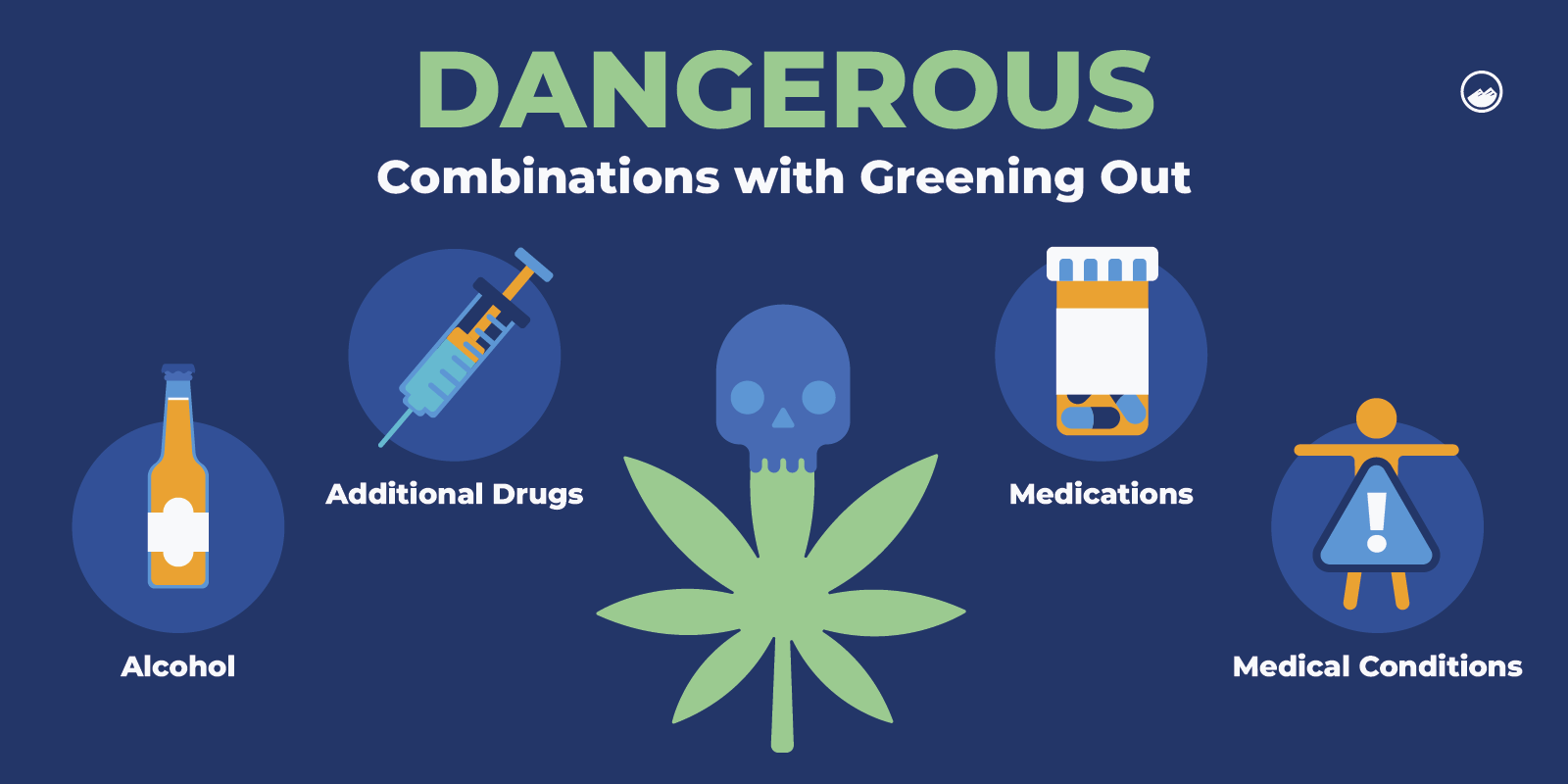
Can You Overdose On Weed?
Yes, you can overdose on weed, though it is different than fatal overdoses from substances like opioids or alcohol.
Greening out is another term for THC toxicity or overdose, which can cause things like extreme anxiety, panic attacks, paranoia, confusion, dizziness, nausea, or vomiting. In rare cases, people may experience hallucinations or psychotic-like symptoms.
While these effects are usually temporary and not life-threatening, they can still be distressing and may require medical attention if someone becomes severely disoriented or dehydrated
It is important for people to understand that “not fatal” does not mean “safe,” especially for teens and young adults whose brains and bodies are still developing.
How to Stop Greening Out
How to Avoid Greening Out?
Greening out can be avoided in a few different ways. The first is to avoid cannabis or marijuana-related substances altogether.
Marijuana detox programs can be very helpful in finding a healthy sobriety from weed.
If the substances are going to be used, it’s important to be aware of the purity, dosage, potency, and way the substance is administered.
For example, it’s important to keep in mind that the effects of edibles are often more delayed than if the substance is smoked. Smoking generally produces side effects almost immediately, whereas it may take a few hours to notice the effects of edibles.
Keeping track of how much and how quickly cannabis products are being taken is the key to keeping yourself safe.

What Are Some Methods of Preventing Greening Out?
- Don’t do it alone
Establish a safe space and have a safe friend nearby to help if something goes wrong. This is not an excuse to pressure others into getting high with you; it’s just an important safeguard to ensure you’re being as safe as possible. - Only use substances from trusted sources
This will reduce the risk of the cannabis product being laced with other substances. Additionally, it will be easier to be aware of the potency and its effects if it comes from a familiar source. - Start slow
Don’t consume more than you’re used to, especially if it’s your first time. Greening out often happens because cannabis users are eager to get high. Consuming small amounts is best to see how the cannabis will affect you before adding more.
How to Not Get Dizzy While High?
Feeling dizzy while high can be a sign that you’re close to greening out, which happens when you use too much cannabis. To avoid this, start with a low dose, especially if you’re new to cannabis or using something with a lot of THC.
Taking too much too quickly can make you feel dizzy and overwhelmed.
Drinking water can help because dehydration often makes dizziness worse.
Eating before using cannabis is also a good idea since it keeps your blood sugar steady, which can stop you from feeling lightheaded. If you do start feeling dizzy, sit or lie down to prevent falling and help your body adjust.
It’s best to avoid mixing cannabis with alcohol, as this can increase dizziness and make things worse. Staying in a calm, familiar space can also help you relax and feel more stable, preventing dizziness from turning into a full greening out episode.
What To Do When Greening Out?
One of the most helpful things when greening out is to stay calm and safe. The more calm you are, the easier it’ll be to listen to your body.
Additionally, if you are greening out, you should:
- Drink water
- Lie down and rest as much as possible
- Take deep breaths
- Smell crushed black peppercorn, which is thought to have terpenes properties that may reduce some of the uncomfortable symptoms
- Seek out medical attention
If you think you’re greening out, you may think that adding more cannabis will help to level out the side effects. In reality, it will most likely continue the greening out cycle. It’s best not to add any additional substances to your body during this time.
Adding substances, including over-the-counter, prescribed, or illicit medications, could cause negative interactions that may result in irreversible damage to your body. The best thing to do is try to rest and contact medical professionals if you’re concerned.
Should You Go to the Hospital After Greening Out?
The greening-out experience will be different for everyone. For some, it may not be life-threatening, and symptoms will dissipate after a few hours of quality rest and hydration.

Others may have more extreme symptoms of greening out, like vomiting, increased heart rate, decreased blood pressure, hallucinations, or extreme paranoia. These symptoms are more likely to occur if cannabis products have been mixed with other substances.
If cannabis is mixed with other dangerous substances, such as alcohol, opioids, or stimulants, the results can quickly become life-threatening.
If you are concerned about yourself or someone else’s safety and well-being, seeking medical attention or contacting emergency services is never a bad idea. Trained providers will know how to handle the symptoms and prevent other, more dangerous issues from arising.
It can sometimes be hard to understand what your body tells you, especially since cannabis significantly heightens the senses and can cause extreme paranoia. If you think something may be wrong, don’t be afraid to seek medical attention or go to the hospital.
How Long Does It Take to Sober Up After Greening Out?
Most symptoms of greening out resolve within 24 hours. However, the time it takes to become sober after greening out will vary for each person.
The intensity and duration of symptoms may be dependent on:
- Hydration levels
- Tolerance
- Amount consumed
- How quickly it was consumed
- If any other substances were consumed
- Co-occurring disorders or other health conditions
How Do I Know If I’m at Risk of Greening Out?
If you’re wondering whether you might be at risk of greening out, here are some factors to consider:
- Low Tolerance
If you are new to cannabis or haven’t used it in a while, your tolerance may be low, making you more susceptible to the effects of THC. - High THC Consumption
Using products that are high in THC, particularly edibles or concentrates, increases your risk. Edibles, for instance, can take longer to feel but may hit harder, often leading to unintentional overconsumption. - Mixing with Alcohol
Consuming alcohol along with cannabis can amplify its effects, increasing the likelihood of greening out. The combination may cause more intense dizziness, nausea, and confusion. - Pre-existing Anxiety or Mental Health Conditions
If you already experience anxiety, panic attacks, or other mental health challenges, cannabis might make these feelings worse. - Dehydration or Low Blood Sugar
Not eating or drinking properly before or during cannabis use can heighten the risk of greening out. Dehydration and low blood sugar can make symptoms like dizziness and nausea worse. - Overconsumption in Social Settings
Feeling pressure to keep up with others or not being aware of how much you’re consuming in a social setting can put you at risk, especially if others have a higher tolerance.
How Do You Help Someone Greening Out?
If you are trying to help someone who is greening out, the best thing to do is to try to keep them calm.
This may be difficult since some of the most common side effects of greening out are anxiety, paranoia, and panic attacks. However, the calmer they can be, the easier it is for them to get through greening out.
Resting is also an important action to take while greening out. This may seem counterintuitive, as for some people, getting high leads to agitation and heightened senses.
It’s important to keep the heart rate as steady as possible since high levels of THC can cause increased heart rate. This significantly increases the chance of heart attack and other dangerous cardiovascular problems.
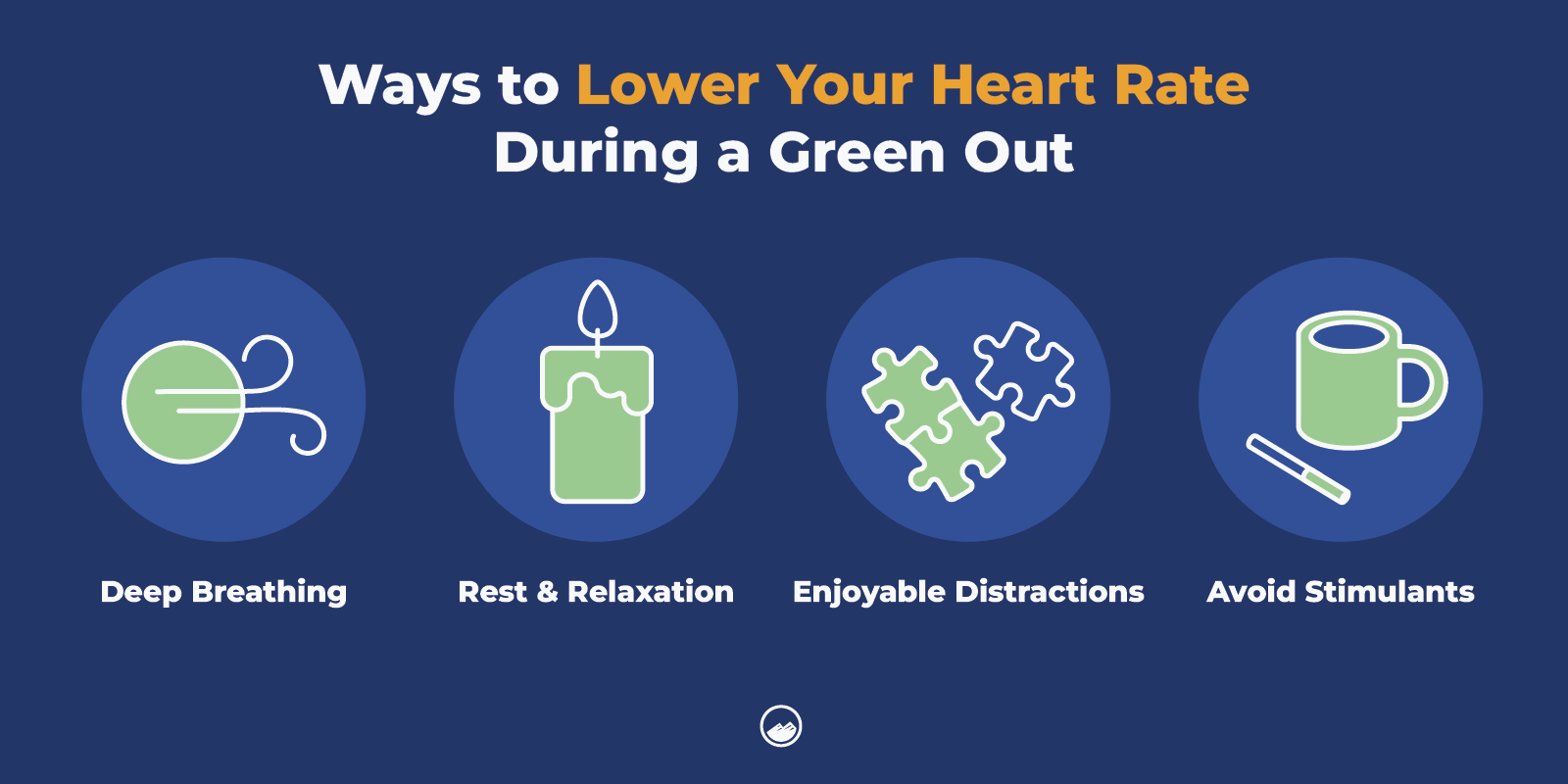
Staying hydrated is another important aspect of getting through greening out. This is especially important if the person has been nauseous or vomiting.
Dehydration can quickly occur, especially with persistent vomiting. If you are helping someone who becomes violently ill following cannabis use, contact emergency services immediately.
If you’re unsure how to help someone greening out, don’t hesitate to contact emergency services. There may be many other factors you’re unaware of that could have irreversible consequences for the person greening out.
The best thing you can do is seek medical attention to ensure everyone’s safety.


Let’s Take the Next Steps Together
At Sandstone Care, we understand the challenges of overcoming excessive marijuana use. Sandstone Care is here to support teens and young adults with mental health and substance use disorders. If you’re ready to heal from your substance use, reach out to us by calling (888) 850-1890







